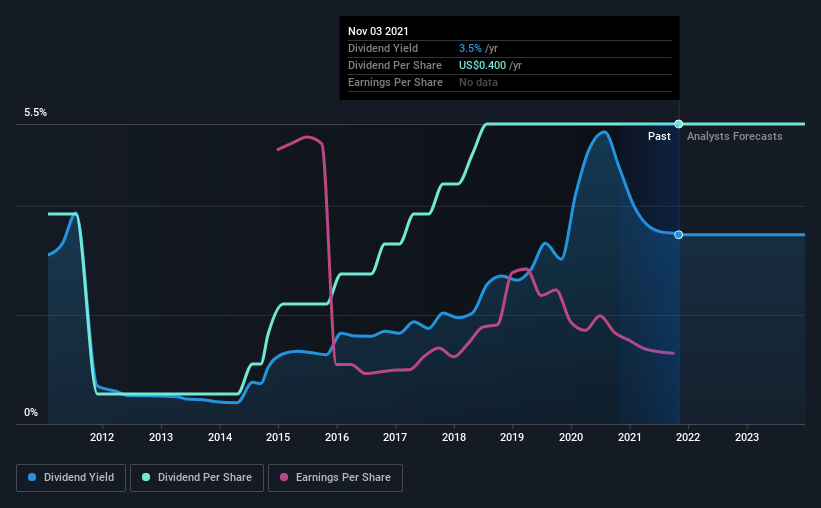
BankFinancial Corporation (NASDAQ:BFIN) will pay a dividend of US$0.10 on the 26th of November. Based on this payment, the dividend yield on the company's stock will be 3.5%, which is an attractive boost to shareholder returns.
View our latest analysis for BankFinancial
BankFinancial's Payment Has Solid Earnings Coverage
If the payments aren't sustainable, a high yield for a few years won't matter that much. Prior to this announcement, BankFinancial's dividend was making up a very large proportion of earnings and perhaps more concerning was that it was 120% of cash flows. Paying out such a high proportion of cash flows certainly exposes the company to cutting the dividend if cash flows were to reduce.
Over the next year, EPS is forecast to expand by 15.0%. Assuming the dividend continues along the course it has been charting recently, our estimates show the payout ratio being 73% which brings it into quite a comfortable range.

Dividend Volatility
While the company has been paying a dividend for a long time, it has cut the dividend at least once in the last 10 years. Since 2011, the dividend has gone from US$0.28 to US$0.40. This means that it has been growing its distributions at 3.6% per annum over that time. It's encouraging to see some dividend growth, but the dividend has been cut at least once, and the size of the cut would eliminate most of the growth anyway, which makes this less attractive as an income investment.
The Dividend Has Growth Potential
With a relatively unstable dividend, it's even more important to evaluate if earnings per share is growing, which could point to a growing dividend in the future. BankFinancial has impressed us by growing EPS at 8.1% per year over the past five years. Past earnings growth has been decent, but unless this is one of those rare businesses that can grow without additional capital investment or marketing spend, we'd generally expect the higher payout ratio to limit its future growth prospects.
The Dividend Could Prove To Be Unreliable
Overall, it's nice to see a consistent dividend payment, but we think that longer term, the current level of payment might be unsustainable. In general, the distributions are a little bit higher than we would like, but we can't ignore the fact the quickly growing earnings gives this stock great potential in the future. We don't think BankFinancial is a great stock to add to your portfolio if income is your focus.
Investors generally tend to favour companies with a consistent, stable dividend policy as opposed to those operating an irregular one. Still, investors need to consider a host of other factors, apart from dividend payments, when analysing a company. As an example, we've identified 1 warning sign for BankFinancial that you should be aware of before investing. Looking for more high-yielding dividend ideas? Try our curated list of strong dividend payers.
Valuation is complex, but we're here to simplify it.
Discover if BankFinancial might be undervalued or overvalued with our detailed analysis, featuring fair value estimates, potential risks, dividends, insider trades, and its financial condition.
Access Free AnalysisThis article by Simply Wall St is general in nature. We provide commentary based on historical data and analyst forecasts only using an unbiased methodology and our articles are not intended to be financial advice. It does not constitute a recommendation to buy or sell any stock, and does not take account of your objectives, or your financial situation. We aim to bring you long-term focused analysis driven by fundamental data. Note that our analysis may not factor in the latest price-sensitive company announcements or qualitative material. Simply Wall St has no position in any stocks mentioned.
Have feedback on this article? Concerned about the content? Get in touch with us directly. Alternatively, email editorial-team (at) simplywallst.com.
About NasdaqGS:BFIN
BankFinancial
Operates as the bank holding company for BankFinancial, National Association that provides banking, financial planning, and fiduciary services to individuals, families, and businesses.
Excellent balance sheet with reasonable growth potential.
Similar Companies
Market Insights
Community Narratives




